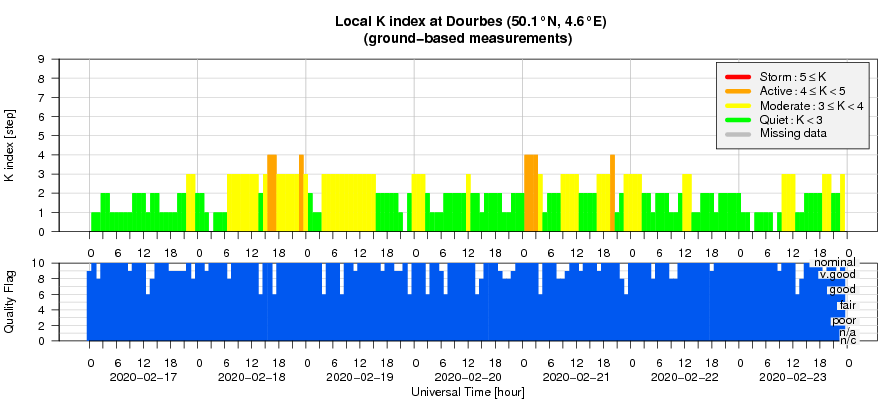- Table of Content
- 1.Jurassic Park....
- 2.Review of sola...
- 3.The Internatio...
- 4.PROBA2 Observa...
- 5.Review of geom...
- 6.Geomagnetic Ob...
- 7.The SIDC Space...
- 8.Review of iono...
2. Review of solar activity
3. The International Sunspot Number by SILSO
4. PROBA2 Observations (17 Feb 2020 - 23 Feb 2020)
5. Review of geomagnetic activity
6. Geomagnetic Observations at Dourbes (17 Feb 2020 - 23 Feb 2020)
7. The SIDC Space Weather Briefing
8. Review of ionospheric activity (17 Feb 2020 - 23 Feb 2020)
Jurassic Park... for SWx Newsitems
Well before the STCE got created in 2006-2007, the SIDC was already doing space weather (SWx) forecasting. Starting in 2000 with daily SWx bulletins, it covered already 7 years before the STCE became operational, thus encompassing the maximum and declining phase of solar cycle 23. During this period, newsitems were also published on the SIDC website, addressing the general public if important SWx events were taking place, or simply giving a heads-up on projects and research. These newsitems included a wide variety of topics, such as aurora as seen from Belgium and the rest of Western Europe, the Halloween events, the assembly of PROBA2 and its solar observing instruments, the first organization of the European Space Weather Week (ESWW),...
Nearly 15 years later, SIDC servers and other IT infrastructure are getting a long-overdue Botox treatment. This would have resulted in the loss of about 100 SWx related news- and press items as published on the SIDC website. To preserve them from a certain extinction, these items have been transferred to the STCE website. Just open the STCE website (http://www.stce.be/ ), then click on any of the tabs at the top of the page ("news", "press", or "good to know"), and click on "last" at the bottom of the page to get to the oldest items. Most archived items are under "news", and it starts with polar light visible in Belgium on 6-7 April 2000.
Enjoy the ride through this Jurassic Park of past, but still very much alive space weather events and research!

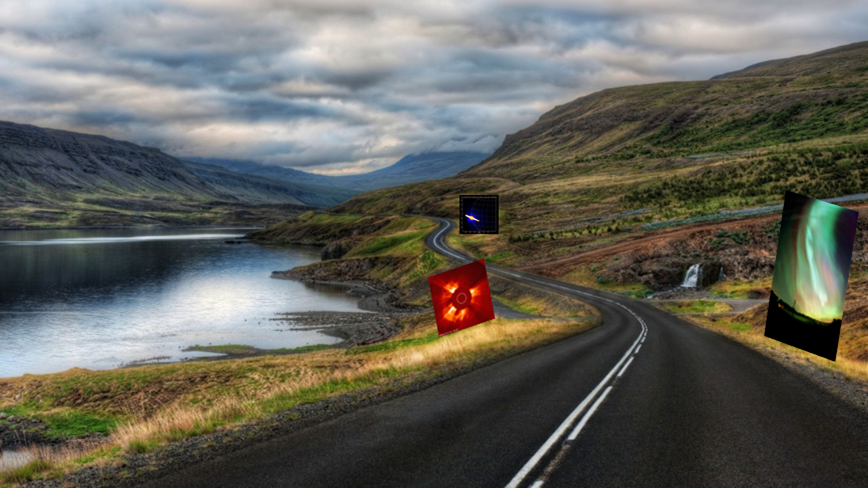
Review of solar activity
The Sun was spotless throughout the week, no active regions visible. Groups of small patchy equatorial negative polarity coronal holes (and the low latitudinal extension of the southern polar coronal hole) were visible on the western hemisphere of the Sun since the beginning of the week.
The pictures underneath from SDO/AIA 304 show some prominence activity at relatively high latitudes (30-50 degrees) on 19 (left) and 21 (right) February 2020.
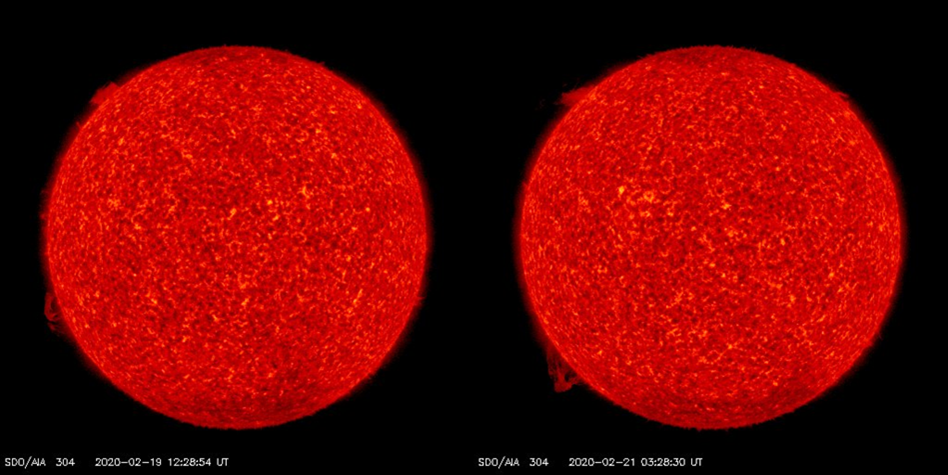
The International Sunspot Number by SILSO
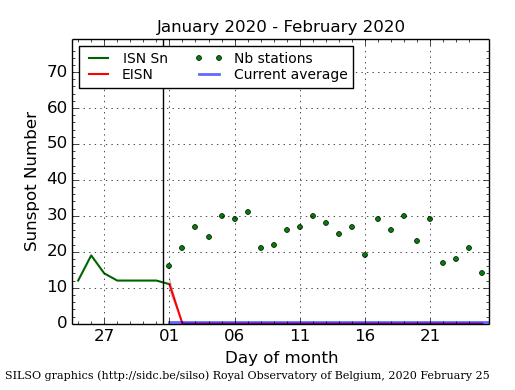
The daily Estimated International Sunspot Number (EISN, red curve with shaded error) derived by a simplified method from real-time data from the worldwide SILSO network. It extends the official Sunspot Number from the full processing of the preceding month (green line). The plot shows the last 30 days (about one solar rotation). The horizontal blue line shows the current monthly average, while the green dots give the number of stations included in the calculation of the EISN for each day.
PROBA2 Observations (17 Feb 2020 - 23 Feb 2020)
Solar Activity
Solar flare activity was very low during the week.
In order to view the activity of this week in more detail, we suggest to go to the following website from which all the daily (normal and difference) movies can be accessed: https://proba2.oma.be/ssa
This page also lists the recorded flaring events.
A weekly overview movie can be found here (SWAP week 517).
http://proba2.oma.be/swap/data/mpg/movies/weekly_movies/weekly_movie_2020_02_17.mp4
Details about some of this week's events can be found further below.
If any of the linked movies are unavailable they can be found in the P2SC movie repository here
https://proba2.oma.be/swap/data/mpg/movies/
Review of geomagnetic activity
On February 18, signatures of an interplanetary coronal mass ejection (ICME) were observed at the Earth (increased magnetic field up to 12 nT, depressed temperature and Bz with negative values for many hours) causing Kp to go up to 5 (K Dourbes up to 4). On February 19 and 21, the arrival of relatively high speed streams to the Earth was observed. The solar wind speed reached 520 km/s and caused active periods both locally and at planetary levels (K and Kp up to 4). On February 23, the solar wind speed reduced to typical slow wind speeds.
In the figure underneath, the passage of the ICME has been indicated by a pink box, and the passage of the enhanced wind streams are in light blue box. The source of the ICME may have been a faint and slow CME leaving the Sun during the morning hours of 12 February (STEREO-A/COR2 coronagraph images, annotated).
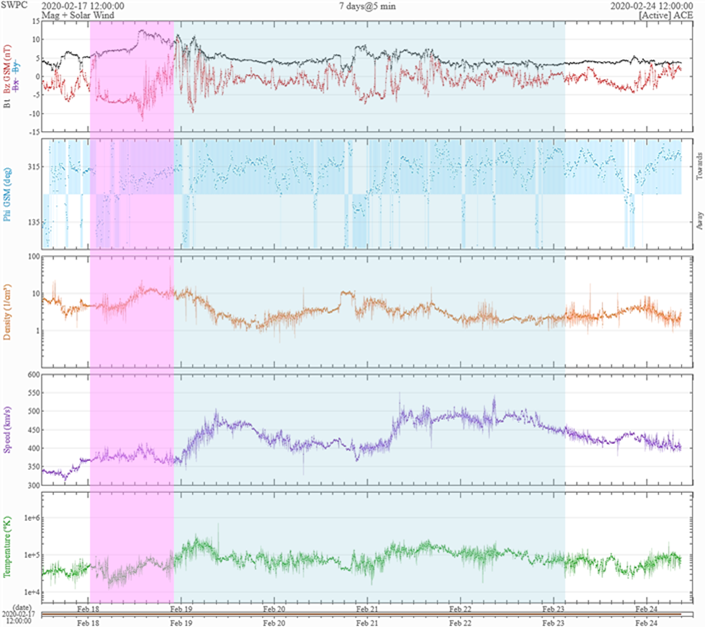
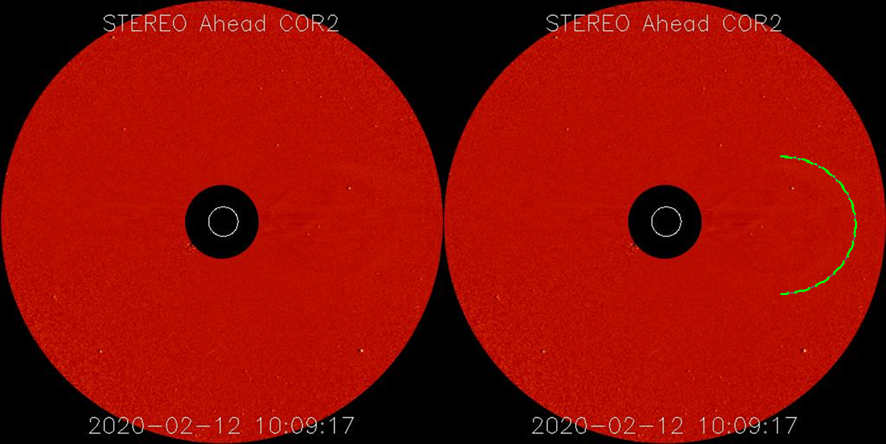
The SIDC Space Weather Briefing
The Space Weather Briefing presented by the forecaster on duty from February 17 to 23. It reflects in images and graphs what is written in the Solar and Geomagnetic Activity reports.
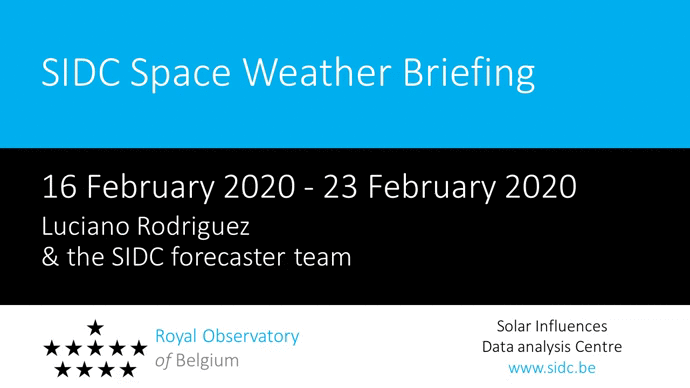
The pdf-version: http://www.stce.be/briefings/20200224_SWbriefing.pdf
The automatically running presentation: http://www.stce.be/briefings/20200224_SWbriefing.gif
Review of ionospheric activity (17 Feb 2020 - 23 Feb 2020)
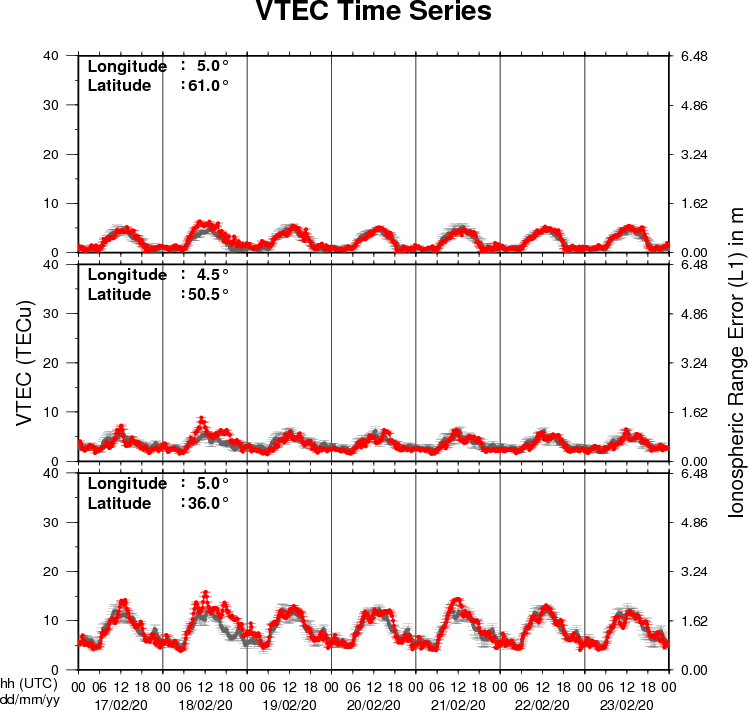
The figure shows the time evolution of the Vertical Total Electron Content (VTEC) (in red) during the last week at three locations:
a) in the northern part of Europe(N61°, 5°E)
b) above Brussels(N50.5°, 4.5°E)
c) in the southern part of Europe(N36°, 5°E)
This figure also shows (in grey) the normal ionospheric behaviour expected based on the median VTEC from the 15 previous days.
The VTEC is expressed in TECu (with TECu=10^16 electrons per square meter) and is directly related to the signal propagation delay due to the ionosphere (in figure: delay on GPS L1 frequency).
The Sun's radiation ionizes the Earth's upper atmosphere, the ionosphere, located from about 60km to 1000km above the Earth's surface.The ionization process in the ionosphere produces ions and free electrons. These electrons perturb the propagation of the GNSS (Global Navigation Satellite System) signals by inducing a so-called ionospheric delay.
See http://stce.be/newsletter/GNSS_final.pdf for some more explanations ; for detailed information, see http://gnss.be/ionosphere_tutorial.php
